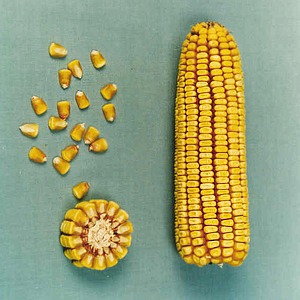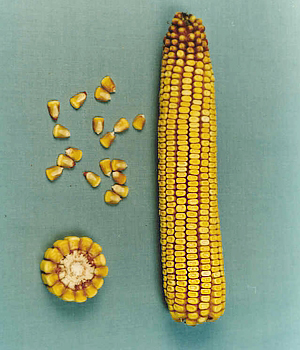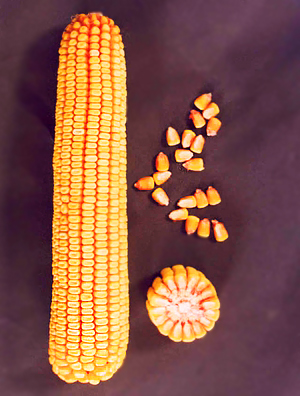Own Varieties
MAIZE HYBRID Rs 424
The common interlinear hybrid Rousse 424 (Rs 424) was created at IASS “Obraztsov chiflik” – Rousse by an authors panel. Regarding the vegetation period it refers to the group of mid-early corns FAO 420. The plants are 175-200 cm high and form ears at 50-65 cm from the soil surface. The ears are 19-21 cm long and with 14 rows. The grain is yellow, typical dent corn.

The hybrid Rs 424 showed high productive abilities and average for the period 1992 – 1996 exceeded the standards Izela and Panoniya varieties by 6,9% and 4,4%, respectively.
The long period from emergence to silking is specific for Rs 424, and it is equal to that of the hybrids of group 300 according to FAO. Also specific is the humidity content in grain in harvesting, which is equal to that of the hybrids from group 430 – 440 according to FAO. Rs 424 showed a good resistance to the diseases of economical importance in maize and a very high tolerance to the stress of draught The optimal stand density of the hybrid Rs 424 is 5500 – 6000 plants per da under conditions without irrigation and 8000 – 8500 plants per da under irrigation.
The hybrid was recognized and regionated at the 52-nd plenum of the State Variety Commission in 1997.
MAIZE HYBRID Rs 464
The common interlinear hybrid Pristis (Rs 464) was created at IASS “Obraztsov chiflik” – Rousse by an authors panel. Regarding the vegetation period it refers to the group of mid-early corns FAO 510.

The plants are averagely 208 cm high and form the first ear at 91 cm from the soil surface. It forms 130 ears per 100 plants under favorable conditions. The ears are 22 cm long and with 12-14 rows. The grain is yellow, typical dent corn. The hybrid Pristis (Rs 464) showed good productive abilities. It exceeded the standards varieties – Kn 460 under irrigation and without irrigation averagely by 8%, R 3737 by 6% and 4,15% respectively and Kn 530 without irrigation by 6%. Its tolerance to stress caused by draught, the good resistance to lodging and diseases in maize of economical importance are valuable qualities. The optimal stand density of the hybrid Pristis (Rs 464) is 5500 – 6000 plants per da under conditions without irrigation and 6500 – 7000 plants per da under irrigation.
The hybrid was recognized as original and regionated for the whole country under the name Rs 464 from the group of the mid-early corns at the 47-th plenum of the State Variety Commission in 1992. It was referred to the group of mid-late corns and renamed to Pristis (Rs 464) at the 52-nd plenum of the State Variety Commission in 1997.
MAIZE HYBRID Rs 555
The common interlinear hybrid Rs 555 was created at IASS “Obraztsov chiflik” – Rousse by an authors panel.

Regarding the vegetation period it refers to the group 500 according to FAO.
The plants are averagely 210 cm high. It inserts its first ear at 90 cm from the soil surface. It forms mдre than 130 ears per 100 plants under favorable conditions. The ears are 18-20 cm long and with 16 rows. Under these conditions it is equal in grain yield to the standard Kn 530, but under stress of draught it exceeds it by 12.5%. Compared to the standard it is harvested with lower content of humidity in grains and its stem is much more resistant to lodging.
Practically it is resistant also to the diseases in maize of economical importance. It was recognized as original and regionated for the whole country in 1994.
MAIZE HYBRID RK 588
The common interlinear hybrid was created at IASS “Obraztsov chiflik” – Rousse by an authors panel.

Regarding the vegetation period it refers to the group 580 according to FAO. The plants are averagely 220 cm high. They insert the first ear at 103 cm from the soil surface. RK 588 forms more than 150 ears per 100 plants under favorable conditions. The ears are 19-20 cm long and with 14-16 rows.
The hybrid RK 588 showed good productive abilities. It exceeded in grain yield the hybrid Kn 530 without irrigation and under irrigation averagely by 9.5% and 5%, respectively, and without irrigation the standard N-780 by 2.7%. It is tolerant to stress caused by draught. Its stem is strong, resistant to breaking. RK 588 is resistant to the diseases in maize of economical importance.
It was recognized as original and regionated for the whole country in 1992.


